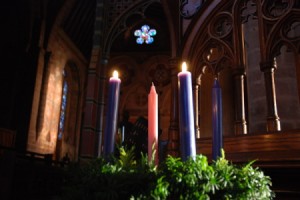
Advent is the beginning of the Christian liturgical year and encompasses the four Sundays before Christmas. It is a season of preparation, anticipation and celebration. As well as a time of preparation for the coming of Christ. It is important for a Universal Life Church interfaith minister to appreciate both aspects of Advent. It is best described as a season of joyful, devout expectation. Christian denominations which celebrate Advent include Catholicism, Episcopalians and Lutherans. However, other denominations are resurrecting Advent as a time of spiritual preparation.
The exact origins of Advent are lost to history. The earliest references to it are from the late sixth century and early seventh. Originally, the season was primarily penitential with a focus on denying the body to enhance the spirit. It was similar to Lent in this respect. Over the centuries Advent has evolved into a more joyous celebration.
The symbols and colors of Advent remind Christians that they are a community which waits in joyful hope for the coming of the Savior, Jesus Christ. The colors for the Advent season are purple, rose and white. Purple, which has long been associated with repentance, symbolizes the spiritual preparation aspect of Advent. As purple is the color of royalty, it also refers to the birth of Christ the King. Rose embodies the rejoicing and celebrating of the modern Advent season. White is for purity. Both Jesus’ purity and the renewed purity of the faithful after Christ washes away sin.
The primary symbol for Advent is the Advent Wreath. An Advent Wreath is a circle of evergreen branches laid on a table or alter. Four candles are place around the circle. Traditionally, three candles are purple and one is rose. A candle is lit each Sunday during Advent with the rose candle saved for last. For Christians, the circle of the wreath symbolizes God’s unending love and eternal life. The candles represent light in darkness. The gradual increasing light reminds Christians that the Light of the World is coming.
Like many Christian symbols, the Advent Wreath has its origins in pre-Christian faiths. Believed to come from northern Europe, the circle represented the eternal cycle of the seasons while the evergreens and lighted candles represented life continuing even in the darkest of winter. A minister to be ordained in the Universal Life Church can use these pagan roots to help Christians and Non-Christians find connection during this season.
There are many religious holidays around the winter solstice. Nearly all of them celebrate birth and rebirth, light returning from darkness and the return of hope. Interfaith ministers who are being ordained in the Universal Life Church must look for ways to emphasize the similar meanings of Advent and other midwinter celebrations. Every year people bemoan the materialism and consumerism which seizes hold of people between November and January. Ordained interfaith ministers can use the practices of Advent, spiritual cleansing and joyful anticipation, as an antidote to these spiritually bankrupt attitudes which are so rampant during these months.

